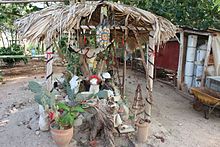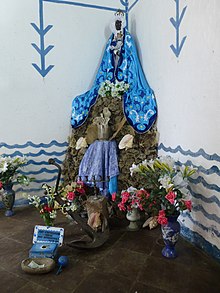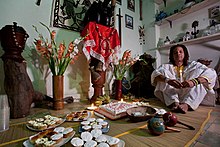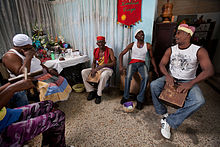 LA “SANTERIA” AFRO-CUBANA DESDE LA IMPOSICIÓN DEL LENINISMO MARXISMO EN CUBA.
LA “SANTERIA” AFRO-CUBANA DESDE LA IMPOSICIÓN DEL LENINISMO MARXISMO EN CUBA.
La revolución cubana de 1959 resultó en que la isla se convirtiera en un estado marxista-leninista gobernado por el Partido Comunista de Cuba de Fidel Castro. Al igual que otros estados marxistas-leninistas, estaba comprometido con el ateísmo estatal y con la erradicación final de la religión, lo que resultó en que el gobierno tomara una visión negativa de la santería. Los practicantes continuaron experimentando acoso policial hasta la década de 1980, se les negó la membresía en el Partido Comunista y se enfrentaron a oportunidades de empleo limitadas. Los practicantes de la santería requerían permiso de la policía para realizar rituales, permiso que a veces se les negaba.
En 1982, el gobierno estableció el Departamento de Estudios Sociorreligiosos (Departamento de Estudios Socio-Religiosos, DESR), que investigó la Santería en Cuba desde una perspectiva marxista, retratando en gran medida la religión como una supervivencia primitiva del animismo y la magia. La investigación del DESR encontró que si bien el cristianismo había disminuido en Cuba desde 1959, la santería no. En parte, esto se debió a que el aumento del empleo entre los cubanos después de la revolución había permitido que más personas pagaran las tarifas de iniciación. Al tomar una visión negativa de la santería, el estado buscó adoptar y promover muchas de las formas de arte asociadas con la esperanza de secularizarlas y usarlas en la promoción de una identidad cubana unificada.
Tras el colapso de la Unión Soviética, en la que Cuba perdió su principal fuente de apoyo internacional, el gobierno de Castro declaró que el país estaba entrando en un “Período Especial” en el que serían necesarias nuevas medidas económicas. En estos años, apoyó selectivamente diversas costumbres y tradiciones afrocubanas tradicionales y legalizó ciertas prácticas de santería. Estas medidas estaban en parte vinculadas al deseo de impulsar el turismo, y el turismo centrado en la santería se llamaba ‘santurismo’. Los espectáculos de piso afrocubanos se hicieron comunes en los hoteles cubanos. Los sacerdotes de Santería, Ifá y Palo Monte participaron en giras patrocinadas por el gobierno para extranjeros que desean iniciarse en tales tradiciones. El alejamiento del gobierno del ateísmo estatal que defendió anteriormente le permitió a Santería dejar atrás la marginación que había enfrentado.
SANTERIA Y EL EXODO CUBANO .
La Revolución Cubana generó un éxodo de muchos cubanos, que se establecieron en otras partes de las Américas, especialmente en los Estados Unidos, Puerto Rico, México, Colombia y Venezuela. Con una mayor presencia cubana en los EE. UU., Santería comenzó a crecer en muchas ciudades grandes de EE. UU., Donde fue adoptada tanto por los latinoamericanos como por los europeos y los afroamericanos. A mediados de la década de 1960, varios practicantes afroamericanos establecieron el Templo Yoruba de Harlem. Algunos de sus miembros lo concibieron como la legítima tradición espiritual del pueblo afroamericano y el ala religiosa del movimiento del Poder Negro. En 1974, la Iglesia de Lukumi Babalu Aye se convirtió en la primera iglesia de la Santería en los Estados Unidos en incorporarse oficialmente.
En la segunda mitad del siglo XX, hubo una creciente conciencia entre los santeros / santeras de los vínculos transnacionales que su religión tenía con otros sistemas de creencias de adoración de orisha en África occidental y las Américas. Esto fue acompañado por un contacto creciente con otros adoradores de orisha en otros lugares. Esto fue influenciado en parte por la visita a Cuba en 1957 del fotógrafo y etnógrafo francés Pierre Verger, quien promovió una teología pan-yoruba. Estos vínculos transnacionales se reforzaron cuando el Ooni de Ife, un destacado líder político y religioso yoruba, visitó Cuba en 1987. El gobierno de Cuba permitió la formación de la Asociación Cultural Yoruba, una organización no gubernamental, a principios de los años noventa. En julio de 2003, La Habana fue sede de la Octava Conferencia Mundial de Orisha.
A finales del siglo XX se produjo un crecimiento en la yorubización (‘Yorubización’) de la santería, con intentos de eliminar elementos católicos romanos de la religión y hacer que se pareciera más a la religión de África occidental. Este proceso fue promovido en el Taller Internacional de Cultura Yoruba, que se celebró en Cuba en 1992. Dentro de Cuba, el proceso de Yorubización a menudo se atribuía a reflejar la influencia de los practicantes en los Estados Unidos. Los nacionalistas culturales cubanos criticaron el proceso de Yorubización, vieron el sincretismo de Santería como un rasgo positivo y argumentaron que los defensores de la Yorubización presentaban a las sociedades homogéneas como superiores a las heterogéneas. Muchos santeros que se opusieron a las reformas destacaron que incluso en África occidental, el culto a los orishas nunca destacó las ideas de pureza y exclusividad. El jefe de la Iglesia Católica Romana en Cuba, el cardenal Jaime Lucas Ortega y Alamino, también se opuso al proceso de Yorubización, creyendo que los elementos católicos romanos de la santería eran una influencia positiva dentro de la religión.
PRACTICE OF CUBAN ‘SANTERIA’.
Dentro de Cuba, la santería se practica tanto en áreas rurales como urbanas y tiene practicantes afrocubanos y eurocubanos. En la isla, la santería se practica principalmente en la provincia noroeste de La Habana y Matanzas. Hay opiniones divergentes sobre cuántas personas practican religiones afrocubanas en la isla. En 1991, el antropólogo cubano López Valdés sugirió que alrededor del 90 por ciento de la población cubana practicaba alguna forma de religión, y que de ese 90 por ciento, un número mayor practicaba una de las religiones afrocubanas que el “catolicismo puro”.
A través de la emigración cubana a México, Santería estableció presencia en Veracruz y Ciudad de México. Entre los practicantes mexicanos, existe la percepción de que los iniciados entrenados en Cuba eran más “auténticos”. Los practicantes mexicanos intentaron mantenerse en contacto con sus correligionarios cubanos por correo y teléfono. En varios casos, los iniciados han sido trasladados desde Cuba a México para realizar rituales específicos.
Santería estuvo presente en los Estados Unidos en la década de 1940; Hay informes de personas de los Estados Unidos que viajan a Cuba para iniciarse en la Santería durante las décadas de 1940 y 1950. Sin embargo, Santería estableció una mayor presencia en los Estados Unidos durante la década de 1960 a medida que un número creciente de migrantes cubanos se trasladó allí a raíz de la Revolución Cubana. Allí, atrajo a conversos de las comunidades afroamericana e hispanoamericana. Samuel Gregory sugirió que en los Estados Unidos, los practicantes de la santería eran más visibles que los del vudú haitiano, en parte debido a la naturaleza más insular de la diáspora haitiana en el país. Señaló que en la ciudad de Nueva York, los diversos casos diferían en su composición étnica, con algunas casas que consistían en gran parte o totalmente de miembros cubanos, puertorriqueños o afroamericanos, y otras eran altamente multiétnicas. Un grupo de la santería de EE. UU. Rompió con los enfoques tradicionales de la religión al formar el Movimiento Yoruba estadounidense, con sede en Carolina del Norte. En 2001, había un estimado de 22,000 practicantes en los Estados Unidos.
A fines de la década de 1980, Santería había recibido un considerable interés por parte de científicos sociales, profesionales de la salud e iglesias establecidas. Algunos ‘santeros’ y ‘santeras’ han notado que desconfiaban de los investigadores académicos y, por lo tanto, eran vagos o deliberadamente engañosos en sus respuestas a las preguntas de estos últimos. La religión también fue explorada en otros medios; la cineasta cubana Gloria Rolando estrenó la película Oggún en 1992. Varias canciones también han hecho referencia a la santería, en particular, los nombres de varios oricha; La exitosa cantante cubanoamericana Celia Cruz, por ejemplo, grabó una versión de “Que viva Chango”.
La santería a menudo se ha enfrentado a la oposición. En Cuba, ha habido mucha oposición del establecimiento clerical católico romano a lo largo de los siglos. Cuando se lanzó el Festival Internacional Afrocaribeño en Veracruz en 1994, exhibió arte y rituales de los ‘santeros’ mexicanos, aunque esto provocó protestas públicas de organizaciones católicas, que consideraban tales ritos como satánicos, y grupos de bienestar animal que consideraban los sacrificios como inhumano. Los organizadores del festival cedieron a la presión, cortando los elementos de Santería del festival para 1998. Varios practicantes también han descubierto que su participación en Santería ha tensado su relación con los cónyuges u otros miembros de la familia que no están involucrados.
 AFRO-CUBAN “SANTERIA” SINCE THE IMPOSITION OF MARXISM LENINISM IN CUBA.
AFRO-CUBAN “SANTERIA” SINCE THE IMPOSITION OF MARXISM LENINISM IN CUBA.
The Cuban Revolution of 1959 resulted in the island becoming a Marxist–Leninist state governed by Fidel Castro’s Communist Party of Cuba. This administration espoused an expressly anti-racist position while retaining previous governments’ focus on cultural integration rather than stressing and encouraging cultural differences among Cuba’s ethnic groups. Castro’s government saw any emphasis on a separate Afro-Cuban identity as being counter-revolutionary. Like other Marxist–Leninist states, it was committed to state atheism and to the ultimate eradication of religion, resulting in the government taking a negative view of Santería. Practitioners continued to experience police harassment through to the 1980s, were denied membership of the Communist Party, and faced limited employment opportunities. Santería practitioners required police permission to perform rituals, permission which was sometimes denied.
In 1982, the government established the Departmento de Estudios Sociorreligiosos (Department of Socio-Religious Studies, DESR), which investigated Santería in Cuba from a Marxist perspective, largely portraying the religion as a primitive survival of animism and magic. The DESR research found that while Christianity had declined in Cuba since 1959, Santería had not. Partly this was because the increased employment among Cubans following the revolution had allowed more individuals to afford the initiation fees. While taking a negative view of Santería, the state sought to adopt and promote many of the art forms associated with it in the hope of secularizing them and using them in the promotion of a unified Cuban identity.
Following the collapse of the Soviet Union, at which Cuba lost its main source of international support, Castro’s government declared that the country was entering a “Special Period” in which new economic measures would be necessary. In these years it selectively supported various traditional Afro-Cuban customs and traditions and legalized certain Santería practices. These measures were partly linked to a desire to boost tourism, with Santería-focused tourism being called ‘santurismo’. Afro-Cuban floor shows became common in Cuban hotels. Priests of Santería, Ifá, and Palo Monte all took part in government-sponsored tours for foreigners desiring initiation into such traditions. The government’s move away from the state atheism it previously espoused allowed Santería to leave behind the marginalization it had faced.
SANTERIA AND THE CUBAN EXODUS.
The Cuban Revolution generated an exodus of many Cubans, who settled in other parts of the Americas, especially the United States, Puerto Rico, Mexico, Colombia, and Venezuela. With an increased Cuban presence in the U.S., Santería began to grow in many large U.S. cities, where it was embraced both by Latino Americans but also European Americans and African Americans. During the mid-1960s, several African American practitioners established the Yoruba Temple of Harlem. Some of its members conceived it as the rightful spiritual tradition of the African American people and the religious wing of the Black Power movement. In 1974, the Church of Lukumi Babalu Aye became the first Santería church in the United States to become officially incorporated.
In the second half of the twentieth century, there was a growing awareness among Santeros/Santeras of the trans-national links that their religion had with other orisha-worshipping belief systems in West Africa and the Americas. This was accompanied by growing contact with other orisha-worshippers elsewhere. This was partly influenced by the 1957 visit to Cuba of the French photographer and ethnographer Pierre Verger, who promoted a pan-Yoruba theology. These transnational links were reinforced when the Ooni of Ife, a prominent Yoruba political and religious leader, visited Cuba in 1987. Cuba’s government permitted the formation of the Yoruba Cultural Association, a non-governmental organization, in the early 1990s. In July 2003, Havana hosted the Eighth World Orisha Conference.
The late twentieth century saw a growth in the yorubización (‘Yorubization’) of Santería, with attempts made to remove Roman Catholic elements from the religion and make it more closely resemble West African religion. This process was promoted at the International Workshop of Yoruba Culture, which was held in Cuba in 1992. Within Cuba, the Yorubization process was often attributed to reflecting the influence of practitioners in the United States. Cuban cultural nationalists were critical of the Yorubization process, viewing Santería’s syncretism as a positive trait and arguing that advocates of Yorubization presented homogenous societies as superior to heterogeneous ones. Many Santeros who opposed the reforms highlighted that even in West Africa, orisha-worship never foregrounded ideas of purity and exclusivity. The head of the Roman Catholic Church in Cuba, Cardinal Jaime Lucas Ortega y Alamino, also opposed the Yorubization process, believing that the Roman Catholic elements of Santería were a positive influence within the religion.
PRACTICE OF CUBAN ‘SANTERIA’.
Within Cuba, Santeria is practiced in both rural and urban areas and has both Afro-Cuban and Euro-Cuban practitioners. On the island, Santería is practiced primarily in the north-west province of Havana and Matanzas. There are divergent opinions regarding how many people practice Afro-Cuban religions on the island. In 1991, the Cuban anthropologist López Valdés suggested that about 90 percent of Cuba’s population practiced some form of religion, and that of that 90 percent, a greater number practiced one of the Afro-Cuban religions than “pure Catholicism”.
Through Cuban emigration to Mexico, Santería established a presence in Veracruz and Mexico City. Among Mexican practitioners, there is a perception that initiates trained in Cuba were more “authentic”. Mexican practitioners tried to keep in contact with their Cuban co-religionists via mail and phone. In various cases, initiates have been flown from Cuba to Mexico to perform specific rituals.
Santería was present in the U.S. by the 1940s; There are reports of people from the U.S. traveling to Cuba for initiation into Santería during the 1940s and 1950s. However, Santería established a larger presence in the United States during the 1960s as growing numbers of Cuban migrants moved there in the wake of the Cuban Revolution. There, it attracted converts from both the African American and Hispanic American communities. Samuel Gregory suggested that in the U.S., Santería practitioners were more visible than those of Haitian Vodou, in part due to the more insular nature of the Haitian diaspora in the country. He noted that in New York City, the various cases differed in their ethnic makeup, with some houses consisting largely or entirely of Cuban, Puerto Rican, or African American members, and others being highly multi-ethnic. One U.S. Santería group broke from the mainstream approaches to the religion by forming the American Yoruba Movement, based in North Carolina. In 2001, there were an estimated 22,000 practitioners in the US.
By the late 1980s, Santería had received considerable interest from social scientists, health professionals, and established churches. Some ‘santeros’ and ‘santeras’ have noted that they mistrusted academic researchers, and were thus either vague or deliberately misleading in their answers to the latter’s questions. The religion was also explored in other media; the Cuban filmmaker Gloria Rolando released the film Oggún in 1992. Various songs have also made reference to Santeria, in particular, the names of various oricha; the successful Cuban American singer Celia Cruz, for example, recorded a version of “Que viva Chango” (“Long Live Chango”).
Santería has often faced opposition. In Cuba, there has been much opposition from the Roman Catholic clerical establishment over the centuries. When the International Afro-Caribbean Festival in Veracruz was launched in 1994, it showcased art and ritual by Mexican ‘santeros’, although this brought public protests from Catholic organizations, who regarded such rites as Satanic, and animal welfare groups who regarded the sacrifices as inhumane. The festival’s organizers relented to the pressure, cutting the Santería elements of the festival by 1998. Various practitioners have also found that their involvement in Santería has strained their relationship with spouses or other family members who are not involved.
Agencies/ Wiki/ Various/ Internet Photos/ Arnoldo Varona/ www.TheCubanHistory.com
THE CUBAN HISTORY, HOLLYWOOD.















